|
Last May I had business in the Central New York area
and wanted to tempt some trout between work and sleep.
Being a semi regular in the Fly Anglers On Line Magazine
chat room I asked the Lady Fisher, Deanna Birkholm, if she
could put me in contact with a fellow from Cortland, New
York that I had chatted with some months ago about winter
fishing in the area.
She said she would be glad to help and told me the gentleman's
name was Comparadun, Leon Chandler. The name rang a bell but
didn't click with me. Deanna mentioned Leon had been a Vice
President of Cortland Line Company for over 30 years and that
he would most likely be able to point me to some good streams
in the area. A few minutes later I had his email address and
the Good Lady's endorsement.
I sent Mr. Chandler an email and invited him to lunch or dinner
to talk about the local fisheries. To my surprise he wrote
back and said to call him when I came to town and he'd
be happy to give me some guidance about the area fishing. He
also said that he could probably arrange a tour of the Cortland
Factory if I was interested.
Everything interests me. Especially fishing related subjects.
So I was pretty excited to get the chance to meet this fellow
and see how fishing line and fly lines are made. There aren't
too many fishing line manufacturers in West Virginia, except
for Dupont, and nobody there ever offered to show me how they
make line anyway.
Now, my curiosity is peaked and when that happens the first thing
I do is run a search on the Internet. I'm into Google Search's
right now because I like the way things come up there. Type in
Leon Chandler and you'll see these three Internet addresses:
www.flyanglersonline.com/features/readerscast/rc83.php;
www.wffj.org/chandler.htm ,
www.cortlandline.com/press_release.php
After viewing these web pages it became evident to me that this guy's not just
another retired manufacturing VP but America's Ambassador to Fly
Fishing no less.
I've been flailing water with fly lines since 1984 and I make the
effort to fish wherever I go and to go wherever there's fish. Most
of my fly-fishing education has come from a one-day beginner
course with a couple of my buddies after two years of living
in total ignorance. The rest of my meager knowledge came from
books, magazines, videos, trial and error and the wisdom derived
from five out of six Professional Guides I've fished with. I say
five out of six because the only thing one of the guides taught
me was to be choosier about guides. It's almost a daily exercise
reading, tying, and talking about fly-fishing but there's more
that I don't know then I do. I've come to the realization
that's the way its always going to be. The opportunity to learn,
first hand, from a man who has helped develop the modern fly line
over the past sixty years is something beyond my grasp normally.
I may be in over my head on this one but that's how I learned
to swim too.
So, I made the ten-hour drive to New York, and worked like a dog
for a week before I had the chance to schedule time to meet Leon
Chandler. My friend, Rick Greene, was with me on the trip and
late Saturday of the first week we stopped at the Cortland Line
Factory Store to buy our licenses and see what they had inside.
The Cortland Line Factory Store is located at 4053 West Road,
Cortland, New York. It's on the West side of New York State 281
just North of the intersection with New York State 222. It's
not a big store in the way of a Cabelas or L.L. Bean but a
comfortable sized fly shop or Pro Shop as Cortland conceptualized
and pioneered in the 1970's.
The shop had a sampling of all the Cortland line of products as
well as some good buys on discontinued items. The checkout
counter separated the fly-fishing and spin fishing sides. I
cruised the spin fishing side quickly and did my usual
micro-scan on the fly side. You could get everything you
need to get started, upgrade your equipment or just add to
your personal inventory of fly-fishing paraphernalia right
here in this shop.
It had the best selection of leaders I've ever seen on one
wall but of course it is Cortland. There were several racks
of rods from the affordable Cortland CL and GRF series that
had a very responsive feel when waggled and looked good too.
The Diamondback line is for the seriously discriminate angler.
These rods are in a class by themselves. The Classic Trout is
designed with a moderate action that brings feel back to casting.
I didn't waggle all the rods but man I wanted to.
There were representatives of all the Cortland reels including
the Embassy, Vista, Vista Turbine, Limited Edition Cortland Turbine
reels LTD, CLX, Crown, Magnum; the list goes on. I never realized
Cortland had so many reels. They also are featuring the STH
Series in partnership with the Argentinian manufacturer of these
high tech and innovative reels.
With all these goodies to look at and gush over the best part
about the shop was the guy who was running it. Joe Wegzyn
is the Store Manager and a great representative of Cortland
Line Company. He's been running the place for about five years
now and says it's growing every year. It's easy to see why.
Joe is eager to point you towards the fish, suggest the right
fly, and show you a neat way to tie a double mono leader for
pike instead of using a stiff wire leader. Besides turning us
on to some sparkle green nymphs that would prove to be deadly
on the stream closest to our hotel he came over after the shop
closed to see if we were having any luck. I've never had a
fly shop owner do that even after laying some considerable
dollars on the counter. Impressive guy.
I promised him not to divulge the fishing spot he sent us to
because he said it was the best kept secret in Cortland County.
I will say that if you like to catch lots of brookies and browns
in the 6" to 12" range and have a good chance to latch on to a
15" to 24" fish you might want to talk to Joe. Rick and I
fished for 2 hours that Saturday evening and caught and released
over 40 fish and at least 30 the next day in about the same amount
of time and never changed flys. True story.
The following Monday while driving down the road I remembered
I had better get in touch with Leon Chandler. I punched in
his number and after a few rings this deep gravely voice
says hello and I tell him who I am. He said Wednesday at
ten o'clock would be good for him and I mentally blocked
out Wednesday from 9:30 a.m. till 2 p.m.
On Wednesday I made my way over to 3736 Kellogg Road and turned
into the gate about five minutes till ten. You drive around to
the left of the big manufacturing complex to get to the front
office. Out front there are picnic tables set up for the
owner/operators of the Cortland Line Company and several people
were on break while enjoying the sunny day. It definitely looked
like an employee friendly place, as it should be, because all
the people who work at Cortland are also the owners. This in
itself is something to be proud of.
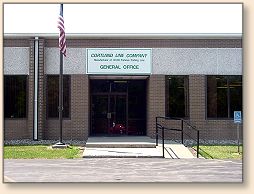
I spotted Leon Chandler tapping his pipe as I pulled up. I knew
what he looked like from one of the web sites that showed him
being inducted into the Freshwater Fishing Hall of Fame. I
parked and started towards the building. Leon had gone inside
so I asked one of the owners where I needed to go to meet him
and was quickly directed to the main office. Leon greeted me
as soon as I came through the door.
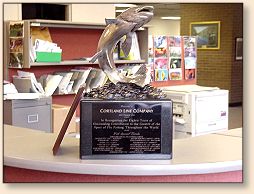 He had a firm handshake and looked me in the eye as we exchanged
names and pleasantries. Leon directed me into the reception area
where we sat down and he asked where I was from and about my
business in NY. I told him about my home and family and
explained the nature of my business and its progress over
the last week. He offered to buy me a cup of coffee and
we talked about the Cortland Line Company in the cafeteria
as different people came and went over the next forty minutes
or so.
He had a firm handshake and looked me in the eye as we exchanged
names and pleasantries. Leon directed me into the reception area
where we sat down and he asked where I was from and about my
business in NY. I told him about my home and family and
explained the nature of my business and its progress over
the last week. He offered to buy me a cup of coffee and
we talked about the Cortland Line Company in the cafeteria
as different people came and went over the next forty minutes
or so.
Ray Smith founded the Cortland Line Company in 1915. He was
an expert in braiding technologies of the day and designed
and produced a series of braided silk lines that propelled
Cortland into one of the leaders in the fishing line industry.
During World War II the Cortland Line Company put recreational
sports to the side and concentrated on producing parachute and
bomb cord. They researched and developed advanced manufacturing
technologies that contributed to the total effort to win the
big one. These new technologies were then transferred into
the fishing industry after the war.
Leon Chandler came from Missouri to visit some relatives in
1941 and started working at Cortland late that same year.
He stayed until his retirement in 1992 after serving as Vice
President for 30 plus years. Leon has been a witness to and
a big part of 60 years of growth and innovation at Cortland.
He has seen all the changes in ownership from the New York
City consortium that purchased the company from Ray Smith
and wasn't very fishing line savvy, to the ESOP that owns
and operates the company today.
Leon moved from the accounting department into marketing after
serving in WW II. He traveled all over the country promoting
the Cortland product line. Eventually, he got involved in the
overseas markets and has been to and fished everywhere except
some parts of Africa.
Because the Japanese market was not doing very well, Leon went
there and put on some exhibitions to promote the sport of
fly-fishing and Cortland's lines. The Japanese market for
fly-fishing was estimated at 300 anglers before Leon went
over. Now there's an estimated 200,000 fly fishermen in
Japan and all of them know Leon on sight, as he's been
back seven times since then.
You can read about the history of fly line development in
Leon's article on Fly Anglers On Line Magazine. It's in the
archives of Readers Casts under features and it's a very
interesting and informative piece.
When our cups were empty Leon led the way into the heart
of the Cortland Line Company where lines are braided, wound,
extruded, dyed, mixed, matched, tested, spooled and packaged.
In the same facility reels are assembled, rods repaired and
matched and balanced Fly Fishing packages are put together.
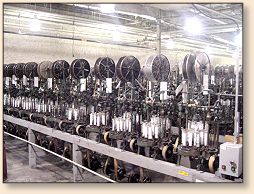
The plant was not running at full capacity the day I was there
so they could do the year-end inventory. As we walked through
the door of the cafeteria into the main braiding area we were
met by a whirring and clattering sound of what had to be a
thousand or so braiding machines (actually about two thousand)
that were continuously turning and winding huge spools of
multifilament yarn into the hundreds of different trolling,
fishing, running and backing lines that Cortland makes. These
machines run 24/7 normally. It was a little overwhelming at
first with all the machines turning spindles of multifilament
yarn in synchronized motion into specific sized lines.
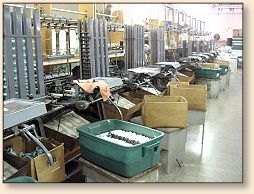 Two types of multifilament yarn are used for two different
purposes: Nylon and Dacron (polyester). The Nylon is used
for making braided nylon bait casting lines, fly line backing
and fly line core stock. The Dacron creates deep-sea trolling
lines because it has less inherent elongation (stretch) than
does nylon.
Two types of multifilament yarn are used for two different
purposes: Nylon and Dacron (polyester). The Nylon is used
for making braided nylon bait casting lines, fly line backing
and fly line core stock. The Dacron creates deep-sea trolling
lines because it has less inherent elongation (stretch) than
does nylon.
Leon said some the spools that were still in use had been
there before he came on board and Leon retired in 1992 after
fifty years with the company. What was amazing to me was
all the intricate parts of the braiding machines and how
they were calibrated and maintained to certain tensions and
speeds that created the product Cortland would deem perfect
enough to sell to the consumer.
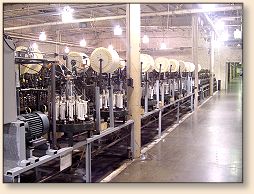
The biggest question that came to mind was who was the guy
(or gal) that figured out how to make all this stuff work
in the first place. Not being very mechanical, it all seemed
too big a mind bender for my feeble brain to comprehend. But
there they were, all working away like little troopers,
spinning out yard after yard of braided monocord and such.
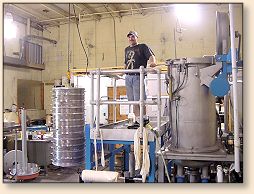 We then went into a dye room where about 16 separate lines
were being unspooled and loaded onto a dying apparatus,
called a Rube Goldberg contraption (named for Rube Goldberg)
that would color trolling line in ten-yard increments so
that you can tell how deep you are trolling. After the
braided line has been despooled and loaded on the dying
machine the operator switched directions and these metal
pans containing all different colored dyes would raise up
in sequence, at just the right time, as the line passed
through each pan in order to dye the line in multicolored
order. Under the pans the floor looked like a huge tie-dyed
T-shirt. It was a pretty neat thing to see.
We then went into a dye room where about 16 separate lines
were being unspooled and loaded onto a dying apparatus,
called a Rube Goldberg contraption (named for Rube Goldberg)
that would color trolling line in ten-yard increments so
that you can tell how deep you are trolling. After the
braided line has been despooled and loaded on the dying
machine the operator switched directions and these metal
pans containing all different colored dyes would raise up
in sequence, at just the right time, as the line passed
through each pan in order to dye the line in multicolored
order. Under the pans the floor looked like a huge tie-dyed
T-shirt. It was a pretty neat thing to see.
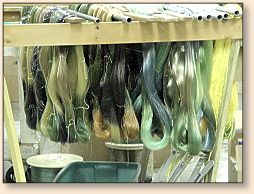
They were making lead core trolling lines called KERPLUNK.
Every 10 yards the color changes and each line comes with
a label that explains the color sequence so an angler can
tell how much line is played out by the color of his reel
spool. It's one of those simple yet ingenious ideas.
In the next room Leon showed me how they make monofilament.
The whole apparatus is called a Monofilament Extruder and it
works like this: On one end of the area was a rectangular
tin about the size of a 2.5-gallon gas can. It was fastened
in a mixer that turned the can over and over making the base
for the monofilament in order to get the color and type of
line they wanted to make. This mix of base material was
then fed into a hopper and the granules were heated into a
liquid then forced under pressure through a nozzle like a
showerhead while in a semi liquid state. About 8 lines are
then arranged on a set of pulleys as they are pulled through
a tub of water that cools the product before it goes through
a series of wooden tensioners that ultimately pull and stretch
the pliable monofilament into the diameter and test strength
of the batch they are running.
Leon handed me a length of monofilament (known as un-oriented
because it hadn't been stretched yet) before it is stretched
and told me to pull it apart as far as I liked. I had about
a foot of line between both hands and pulled as far as my arm
span would accommodate. The line got thinner and thinner
until I quit applying pressure. When I stopped pulling the
molecules in the line set up and I couldn't stretch the line
any more. That's how the machine works. As long as constant
tension is applied the monofilament lengthens and the diameter
reduces up to the point that the tension stops, thereby making
it oriented as the final product. The result should be the
size and test that the batch was designed to be. There's a
quality control person who tests every 6th batch and if the
line doesn't meet Cortland's exacting standards its recycled
and reprocessed.
There's a room where the owners assemble the STH Reels and
repair rods. They all looked pretty busy and we didn't bother
them too much. Leon told me the STH Reels are assembled in
Cortland from parts made in Argentina. The manager of the
assembly operation is Juan Sacconi an Argentinean and the
son of the STH owner Robert Sacconi. Cortland is the
distributor of the reels in the US and Canada. STH distributes
to the rest of the world.
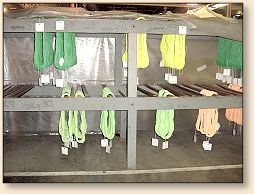 Leon then showed me where they dye skeins of lines that become
the core of fly lines. They had a new type of machine that
Leon hadn't seen in operation before but he said it was
supposed to be more efficient then the regular system.
Innovation and technology development are what keeps a
company like Cortland on the leading edge of the industry.
Leon then showed me where they dye skeins of lines that become
the core of fly lines. They had a new type of machine that
Leon hadn't seen in operation before but he said it was
supposed to be more efficient then the regular system.
Innovation and technology development are what keeps a
company like Cortland on the leading edge of the industry.
We didn't see the process that Cortland uses to apply the
tapered coating of the fly line. This is a closely guarded
trade secret and very few people are allowed in the area
where this is performed. Leon told me that the outside
coating is made up of a PVC containing millions of microscopic
glass beads that are hollow and trap air. The line floats
because of the air in the glass beads. The formulation has
to be precise so that there is enough buoyancy and enough
diameter to allow them to cast well.
The fly lines are then formed into single tapered, double
tapered, rocket head and all the other configurations that
Cortland uses to make the 350 different fly lines that are
on the market today. When the lines are processed they come
out in one continuous length that have to be cut into
individual lines. These spools are pulled through a counter
and through the fingers of some ladies with extra sensitive
feel to check for imperfections. These ladies inspect every
inch of the fly line and are thoroughly experienced at what
they do. Leon informed me that one lady, who had retired
shortly before my visit, worked for 35 years as an inspector.
"It is interesting to speculate where all the fly lines
went - and people who used them - that had passed through
her fingers during the 35 years," Leon later told me.
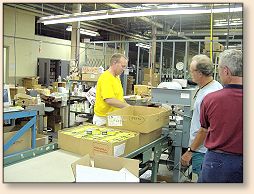
While on a steelhead fishing trip in Michigan the prior April
I had to strip 40 to 50 feet of line through my fingers all day.
After about the tenth time, I realized I was going to cut a
groove in my stripping finger if I kept this up for eight
hours so I put on a couple of Band-Aids to ward off the cuts
and blisters. By the end of the day the Band-Aid was ripped
to pieces and barely hanging on.
I asked the lady who was checking the line how she kept that
from happening and Leon had her show me her finger. She said
there was a foot-operated brake that stopped the line where
she needed to cut it but some times she forgot to use the brake
before she clamped down tight on the line. Her fingers showed
the result of forgetting to use the brake in the crease of the
first joint of the index finger. She said you don't do that
too many times before you learn not to grab the line too soon.
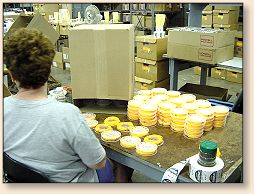 If these quality control experts feel any flaws in the line
it is removed and labeled imperfect. I asked what the percentage
of imperfect lines was and Leon said it was very low considering
the number of lines produced every year. I also asked if the
imperfect lines were sold at a discount and Leon informed me
that Cortland will not sell any line that does not meet it's
exacting standards and that they feel the public deserves only
Cortland's best product and nothing inferior is ever sold.
That's the reason their lines aren't discounted. They do,
however, pass on some of the imperfect lines to their pro
shops for demonstrations and promotional use.
If these quality control experts feel any flaws in the line
it is removed and labeled imperfect. I asked what the percentage
of imperfect lines was and Leon said it was very low considering
the number of lines produced every year. I also asked if the
imperfect lines were sold at a discount and Leon informed me
that Cortland will not sell any line that does not meet it's
exacting standards and that they feel the public deserves only
Cortland's best product and nothing inferior is ever sold.
That's the reason their lines aren't discounted. They do,
however, pass on some of the imperfect lines to their pro
shops for demonstrations and promotional use.
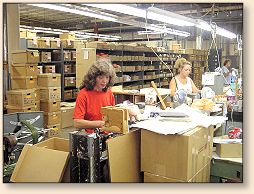
Leon is a great believer in cleaning your line before every
outing. He explained that there's always dirt, pollen and other
small particles in the waters film that cling to your line and
after a while the buildup will counteract the buoyancy of the
fly line and adds to the disturbance on the water when you lift
it for your next cast. Every Cortland Fly Line comes with a
little cleaning pad and Leon suggests we use them, regularly,
to maintain the lines floating capabilities.
Our next stop was with a lady who was putting together some
kits for beginners that were earmarked for a youth camp
somewhere that Cortland supports. Cortland also was one
of the pioneers in offering Balance Fly Rod Outfits,
complete with rod, reel, line, leader backing, and in
later years an instructional video. I've watched this
video numerous times with friends and I must say its one
of the best ones I've seen as a way to introduce a
new-comer to the sport.
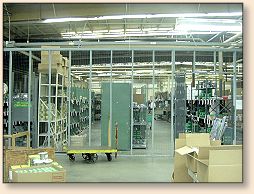 Adjacent to this was the stock room area where all the
different products are shelved and orders are filled and
shipped. As with all manufacturers there's a fine line
between having too little and too much inventory on hand.
Over the years the people at Cortland have developed a
system that anticipates demand and they try to have enough
of their products on the shelf, ready to go, at the right
time. If this area were a fly shop it would have the most
complete array of fly fishing lines, reels and rods you've
ever seen.
Adjacent to this was the stock room area where all the
different products are shelved and orders are filled and
shipped. As with all manufacturers there's a fine line
between having too little and too much inventory on hand.
Over the years the people at Cortland have developed a
system that anticipates demand and they try to have enough
of their products on the shelf, ready to go, at the right
time. If this area were a fly shop it would have the most
complete array of fly fishing lines, reels and rods you've
ever seen.
Our tour was coming to an end and my head was swimming trying
to file away all the information that I had been exposed to so
I could tell my fishing buddies what I had learned. Leon asked
me what size rod I used and preceded to give me four rolls of
Lazer Line to try out. One roll was a Nymph Tip Line that Leon
held the patent on before it expired. I can't wait to put that
one on and see how it works. Of course he also gave me some
line cleaning pads to keep them in good shape. As much as I
fish, and with a thirteen year old son who never passes up
the chance to come with me, these lines will be put to good
and frequent use.
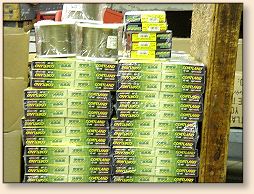
We sat back down in the cafeteria and Leon showed me some places
on my map to fish on the Beaver Kill and Delaware Rivers, just
an hour and a half away from Cortland. I've wanted to try these
streams ever since I started reading about fly-fishing, but I
never got the chance to go to these rivers over the next two
weeks that I was in the area. I guess I'll have to make a
return trip later this fall to try these fabled streams, and
maybe I can get Leon to come along.
Altogether, this trip to New York turned out to be uncommonly
fortuitous to my business interest and especially gratifying
to my fly-fishing interest. Having met some of the dedicated
people like Leon Chandler, Joe Wegzyn, and all the other
owners who strive to produce a superior product, I've gained
a newfound respect and admiration for the company and the
people who make it work at the Cortland Line Company.
~ Bo Ranson
|


 He had a firm handshake and looked me in the eye as we exchanged
names and pleasantries. Leon directed me into the reception area
where we sat down and he asked where I was from and about my
business in NY. I told him about my home and family and
explained the nature of my business and its progress over
the last week. He offered to buy me a cup of coffee and
we talked about the Cortland Line Company in the cafeteria
as different people came and went over the next forty minutes
or so.
He had a firm handshake and looked me in the eye as we exchanged
names and pleasantries. Leon directed me into the reception area
where we sat down and he asked where I was from and about my
business in NY. I told him about my home and family and
explained the nature of my business and its progress over
the last week. He offered to buy me a cup of coffee and
we talked about the Cortland Line Company in the cafeteria
as different people came and went over the next forty minutes
or so. 
 Two types of multifilament yarn are used for two different
purposes: Nylon and Dacron (polyester). The Nylon is used
for making braided nylon bait casting lines, fly line backing
and fly line core stock. The Dacron creates deep-sea trolling
lines because it has less inherent elongation (stretch) than
does nylon.
Two types of multifilament yarn are used for two different
purposes: Nylon and Dacron (polyester). The Nylon is used
for making braided nylon bait casting lines, fly line backing
and fly line core stock. The Dacron creates deep-sea trolling
lines because it has less inherent elongation (stretch) than
does nylon.
 We then went into a dye room where about 16 separate lines
were being unspooled and loaded onto a dying apparatus,
called a Rube Goldberg contraption (named for Rube Goldberg)
that would color trolling line in ten-yard increments so
that you can tell how deep you are trolling. After the
braided line has been despooled and loaded on the dying
machine the operator switched directions and these metal
pans containing all different colored dyes would raise up
in sequence, at just the right time, as the line passed
through each pan in order to dye the line in multicolored
order. Under the pans the floor looked like a huge tie-dyed
T-shirt. It was a pretty neat thing to see.
We then went into a dye room where about 16 separate lines
were being unspooled and loaded onto a dying apparatus,
called a Rube Goldberg contraption (named for Rube Goldberg)
that would color trolling line in ten-yard increments so
that you can tell how deep you are trolling. After the
braided line has been despooled and loaded on the dying
machine the operator switched directions and these metal
pans containing all different colored dyes would raise up
in sequence, at just the right time, as the line passed
through each pan in order to dye the line in multicolored
order. Under the pans the floor looked like a huge tie-dyed
T-shirt. It was a pretty neat thing to see.
 Leon then showed me where they dye skeins of lines that become
the core of fly lines. They had a new type of machine that
Leon hadn't seen in operation before but he said it was
supposed to be more efficient then the regular system.
Innovation and technology development are what keeps a
company like Cortland on the leading edge of the industry.
Leon then showed me where they dye skeins of lines that become
the core of fly lines. They had a new type of machine that
Leon hadn't seen in operation before but he said it was
supposed to be more efficient then the regular system.
Innovation and technology development are what keeps a
company like Cortland on the leading edge of the industry.
 If these quality control experts feel any flaws in the line
it is removed and labeled imperfect. I asked what the percentage
of imperfect lines was and Leon said it was very low considering
the number of lines produced every year. I also asked if the
imperfect lines were sold at a discount and Leon informed me
that Cortland will not sell any line that does not meet it's
exacting standards and that they feel the public deserves only
Cortland's best product and nothing inferior is ever sold.
That's the reason their lines aren't discounted. They do,
however, pass on some of the imperfect lines to their pro
shops for demonstrations and promotional use.
If these quality control experts feel any flaws in the line
it is removed and labeled imperfect. I asked what the percentage
of imperfect lines was and Leon said it was very low considering
the number of lines produced every year. I also asked if the
imperfect lines were sold at a discount and Leon informed me
that Cortland will not sell any line that does not meet it's
exacting standards and that they feel the public deserves only
Cortland's best product and nothing inferior is ever sold.
That's the reason their lines aren't discounted. They do,
however, pass on some of the imperfect lines to their pro
shops for demonstrations and promotional use.
 Adjacent to this was the stock room area where all the
different products are shelved and orders are filled and
shipped. As with all manufacturers there's a fine line
between having too little and too much inventory on hand.
Over the years the people at Cortland have developed a
system that anticipates demand and they try to have enough
of their products on the shelf, ready to go, at the right
time. If this area were a fly shop it would have the most
complete array of fly fishing lines, reels and rods you've
ever seen.
Adjacent to this was the stock room area where all the
different products are shelved and orders are filled and
shipped. As with all manufacturers there's a fine line
between having too little and too much inventory on hand.
Over the years the people at Cortland have developed a
system that anticipates demand and they try to have enough
of their products on the shelf, ready to go, at the right
time. If this area were a fly shop it would have the most
complete array of fly fishing lines, reels and rods you've
ever seen.